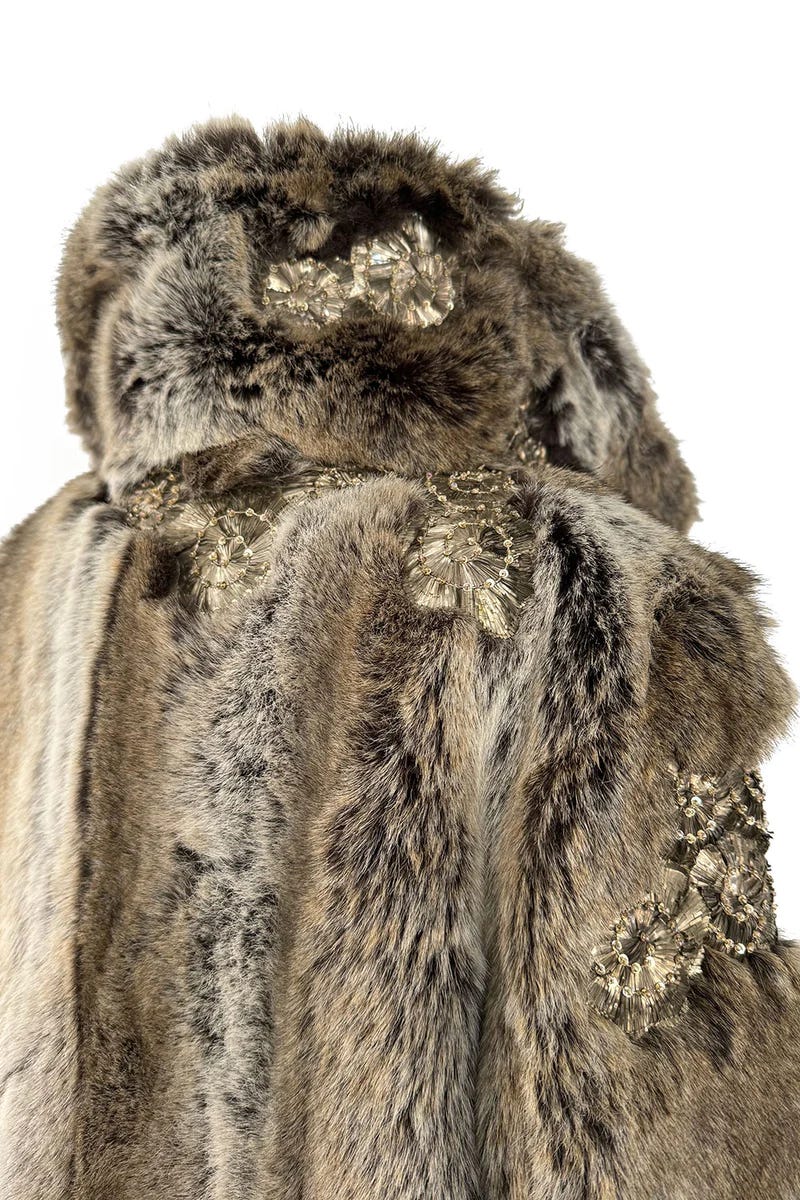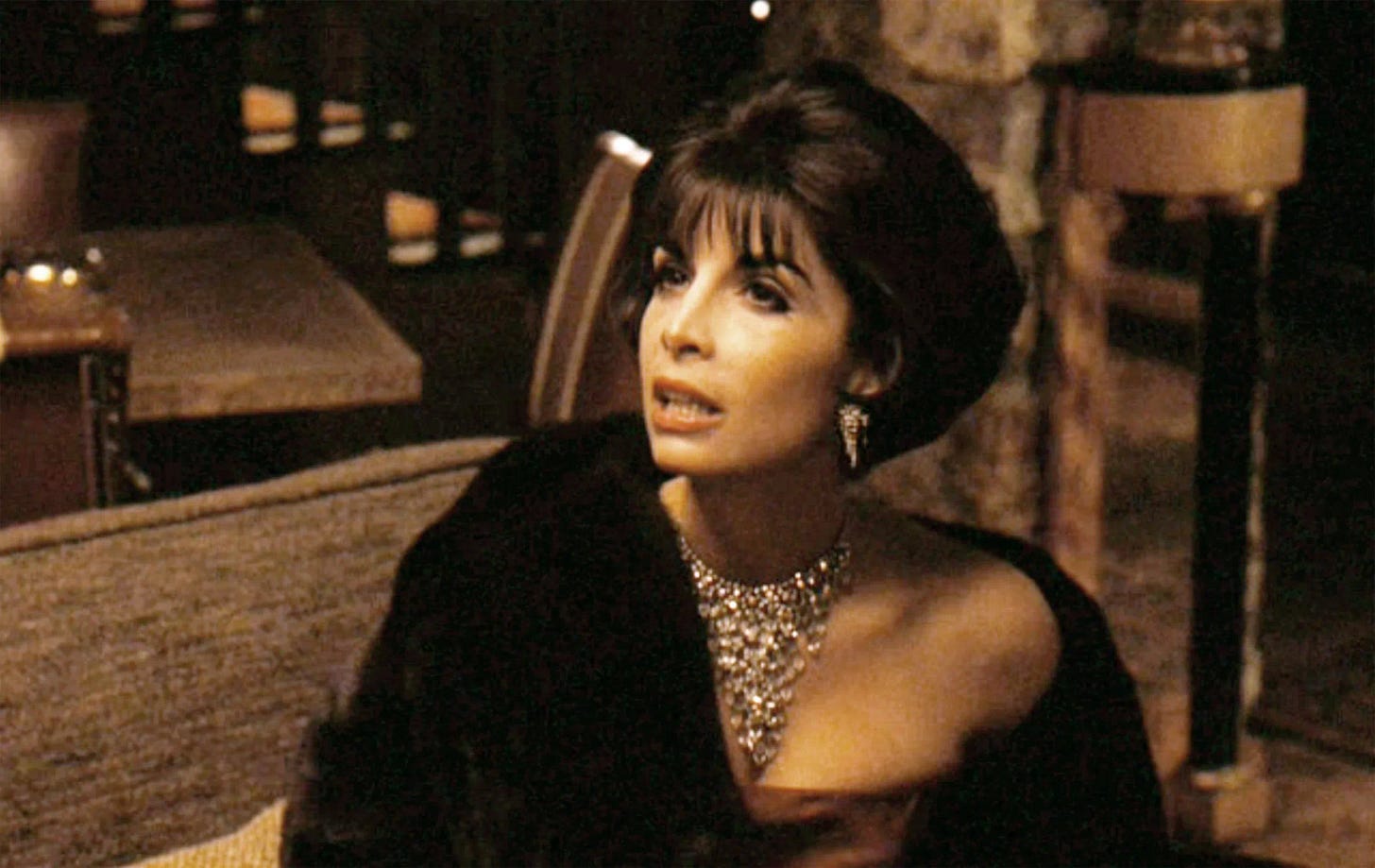“I wasn’t sure whether to wear it. I’ve been hearing that fur is out.” These were the lamentations of the chic Connecticut visitor whose voluminous caramel fur coat I complimented. She seemed confused, not quite alarmed, and still living in a world where trends ebbed gracefully “in” and “out” rather than with the finality and viciousness of permanent cancellation.
Nobody can seem to agree if fur is canceled either. Prepare for a niche internet tirade: a woman posts a tik tok about wearing vintage fur to a bar, is asked if it is real, and then is asked to leave. While the old money WASPs defend the hoarding of grandma’s furs against new money trend chasers championing faux fur, a new sector of tik tok begins circling something called “mob wife” chic. These adherents have chosen a terrible name for something deeply pedestrian: a pastiche of the then trashy Nouveau Riche that flaunts elegance via gorgeous jewelry, a slinky dress, and inevitably, fur. PETA proclaims from the sidelines that all fur glamorizes animal torture, and should thus be avoided entirely. This argument calls to mind the endless storage centers of confiscated, illegal animal goods - hidden to prevent their sale, glamorization, or copying, and thus rendered useless units of space. Opinions inevitably tangle, and the motivations for a feeling one way or the other become colored by trend, personal affront, and ethical fervor.
The unit of the trend is inherently in the service of consumerism, and the defense of trend for its own sake can come perilously close to one tearfully defending their “right” to purchase. For every person defending the uncovering of their family ermine is one who spends hundreds on an old one, or even (gasp) a new one. For every repurposed bow in a woman’s hair is a newly tailored blazer covered in new bows. For every 90s JNCO denim is a Balenciaga pair imported from Japan, double washed, and rinsed in ethical ambiguity. Yola Mzizi confronts this issue in a piece for Business of Fashion, explaining the paradox of buying into trends, even those rooted in vintage. She writes,
The trouble with ideologies that generalize what cannot be worn is the lack of a vision for what to do with endless products made undesirable. As trend cycles quicken, discourse over the ethics, influence, and meaning of a trend is crunched into a blip as inconsequential as the trend itself. The result is a feeling that avoiding or participating in said trends, let alone opining about them, means increasingly little.
Travel above 55th Avenue on a windy winter day and this becomes abundantly clear; fur is everywhere. There aren’t beady-eyed little stoles, but hats, collars, and coats of every make and era. This is not in booming defiance of any social code. Like the Connecticut woman who puts on her coat and learns it may not be in style, it is a more natural state of dress (one that was in part being replicated by nouveau riche “mob wives” and tik tokers alike). More fascinating to me is the state of fur when this generation of uptown socialites fades: will the next generations wear their furs?
It’s important to ask because, well, there’s a lot of fur out there. Between the closets, landfills, racks, bo utiques, and factories there remains a wealth of furs, real and faux alike, being stored, hoarded, and constructed. Is fur amoral enough to prevent any of these pieces from being worn, or must they sit in a hidden holding cell? Wearing old clothes will always be kinder to the environment than buying “new“ or newly made clothes, especially those made with a Petroleum base like modern faux. In that sense, does one attempt to break through the noise of the discourse to argue for ways of repurposing the ethically ambiguous, or do we wear and prepare to defend ourselves? Certainly, there’s plenty of old Balenciaga, Yeezy, Gosha Rubchinskiy, and Alexander Wang out there that could cause a stir if worn out, and that’s before even touching the truly unsavory stuff.
Beyond the issue of trend viciously circulating what we may wear and discard in a frenzy of consumerism, is the question of how we may be convinced to pivot to a mindset of purchasing garments for their ability to be worn, hopefully with consistency and longevity. Where is the mindset to prepare us to own clothes that can weather a dark future?
Milan and Paris menswear weeks have served as new indicators of brand responses to and concoctions of trend to weather said future. As the latest tastes skew towards “quiet luxury” interpretations of the trend via ubiquitous and conservative slim cuts, and suiting disappear the graphic, make the logo more subtle, and distance fashion from the clothes everyday people wear and have access to. There is an insinuated essential quality imbued with these new clothes. We are presented with uniforms, chameleon skins to blend with wherever we may go, and trends that illustrate ways of deviating from all the homogeneity.
Amidst the endless suiting and general reliance on traditional prep and national heritage codes was the unifying motif of the yellow jacket. Designers known for niche uniforms consistently painted their offerings in yellow, from John Alexander Skelton’s ragged Victorian set, Kiko Kostadinov’s modular and technical offerings (some paired with green vests, asymmetrical tanks, or matching yellow headbands), or Ernest W Baker’s 70s western wear offering. Along with a pale Meyer lemon suit, SS Daley showed a brilliant yellow barn coat evoking a romantic English farm, while Louis Vuitton’s yellow barn coat recalled a swooning American West. A dustier yellow, still inspired by the old (albeit Europeanized) West closed Paul Smith’s show, the goldish hue appearing earlier as a vest and panel on shirts and pants. Kenzo showed a yellow letterman, Wales Bonner a yellow moto jacket, Dries Van Noten a faded yellow cheetah print trench, Walter Van Beirendonck a modular jacket with cutouts and a belt, and even Rick Owens presented a fuzzy yellow blob of a top among the black and leather. In the colorful shows yellow was given its own look, and in the many monochrome shows yellow was the outlier.
What is the conceit of a yellow jacket? It is a color more rarely seen on tops, a harder hue to disentangle from road safety day-glo and the unpinpointed gauche. Yellow arrives here as a color to disturb the otherwise perfectly wearable object, yet its association with the rubbery raincoat or the dusty barn jacket reinforces an association with utilitarian objects made fabulous. The yellow jacket is fashion grasping at the embers of flagrant maximalism.
While most graphics disappeared this season (save art prints specifically in the style of last year’s wildly popular SS24 Undercover Show), one animal was utilized in a surprising variety of shows. JW Anderson’s presentation, which seemed to rebuke any desire for or sense of “quiet“ or “slim cuts”, featured a giant fuzzy sweater with a cat. Givenchy’s show, the first since Matthew Williams’ exit and one of their recent best, explored refined suiting with simple and muted colors, as well as a cat motif (founder Hubert’s famous pet). furry coats (hopefully faux!) resembled the long haired cats that peeked through even fuzzier bombers and bags and stared from tank top prints. Mihara Yasuhiro’s show recalling youth memories of oversized clothes also included red and black sweaters with tabby cats. These are not the snarling dogs of Ricardo Tischi’s Givenchy, Moschino cartoon animals, nor Gucci embroidered bees and lions of old. The admittance of the feline into “quiet luxury” may represent a holdover from these graphic, extravagant times. Their presence may serve as the repudiation of quiet, or the opening of a market for whom graphics can be fashioned into the quiet.
These observations are the tip of the iceberg. Western wear as a whole has been proclaimed as “in” shortly after Pharrell’s Louis Vuitton show. Ribbons and bows (harbingers of coquette-core) emerged in different forms at Sacai, Kenzo, Gucci, and Loewe. Menswear once again turned to the codes of womenswear for flavors of subversion, and it was just as subversive as last season. Sailors were everywhere. And yet, of this crop perhaps only a fraction of these motifs will actually blossom into trend by next autumn.
It is perhaps for this very reason that menswear weeks felt divided, if not fraught. Faced with the turnover of trends and the ephemerality of vitality, few seemed totally willing to commit to a vision of “quiet“ or “loud“, suiting without exception, risk without marketable backup. The sense of desperation in these exercises of trend adjacency undermine the cool confidence and consistency of actual stealth wealth stalwarts like Loro Piana or Cucinelli. Ultimately, just as Mzizi reminds us with fur, the only ones profiting from these trends, even those based loosely on “craft” or esoteric signifiers of expensiveness, will be fast fashion retailers.
It is telling that the most successful and compelling shows did not participate in this conversation. Some of my favorite shows - Walter Van Beirendonck, SS Daley, or Junya Watanabe (shocker) - stayed their course of catering simply to their niche customers by offering products which fell within the general patterns of the weeks, but always felt natural for the brands. Consider that last week, two of Couture Week’s most popular shows were the insular, self referential, and decidedly “loud” John Paul Gaultier by Simone Rocha, and Galliano/Margiela presentations. The specific lauding of these shows by critics and fans as “historical“, as well as invitations to analyze Rocha’s diverse Gaultier show inspirations and Galliano’s famous shows present a dynamic that favors longevity and narrative over constancy.
So much clothing is being produced all the time, and mostly without the passion for history and longevity, nor the consideration of longtime wear. Even so, what to do when we find a runway acceptable, terrible, or actively destructive to art and life? What happens to that excess, how is it disseminated, forgotten, or hopefully recontextualized to be worn?
There is a discordance in watching hundreds of runway images from just two weeks of fashion shows while processing the issues with consuming trends. On the same day that I met that Connecticut woman in furs, I saw more women than I could count with bows and ballet flats, at the counters of boutiques looking for viral bags that had sold out, some even wearing boots popular not two seasons ago.
Ultimately though, there will be fewer and fewer of the naive fur toters, and far more aging millennials with bows, baggy pants, and cowboy boots in their closets. Beyond the well crafted furs and vintage of old, who will be wearing today’s trends in our mysterious tomorrow?









